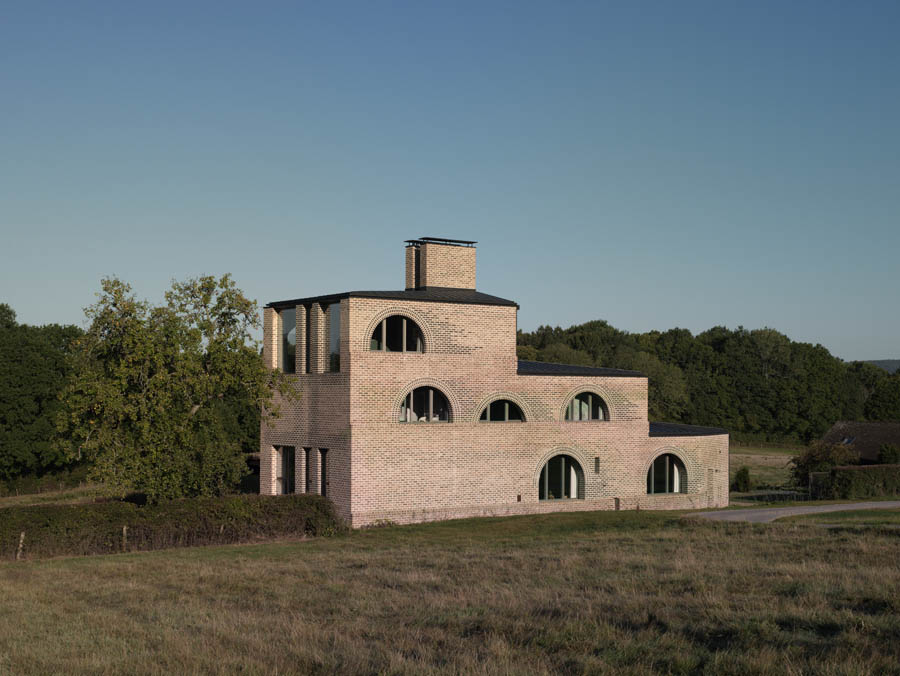
November 6, 2019
An Architect’s House Filled With Cosmic Energy and Historical References Rises in the South of England
Adam Richards based the design of his Sussex home on the Tarkovsky film Stalker, filling it with art, maps, and ample cultural symbolism.

I feel for Adam Richards and his family, particularly his wife, who must have been a bit worried when a planner asked the British architect if his proposed house was “providing some form of therapy.” Richards was intent on basing his new home in Sussex, England, on Andrei Tarkovsky’s film Stalker, which, in Richards’ words, is “about three miserable old men stumbling through a post-industrial landscape.”
Specifically, Stalker is premised on the miserable men searching for a sacred “zone,” the reward for finding it sometimes being death. Metaphors from the film are firstly found in plan—the house resembles a giant coffin. “I don’t plan to die there,” Richards reassures me.
Upon a visit to the house, the ominous overtures quickly give way to a more rosy reality. Two (of three) children are celebrating their 5th and 9th birthdays. It’s not total chaos—the festivities are just dying down—but the place is certainly alive and already feels lived in.
Richards moved south to Sussex five years ago from East London, where his eponymous practice is still based, renting a cottage in the southern county for the past three years while working on the family home.
Despite sitting in the open countryside, the house is easily missed, hidden behind a copse and its sloping road far from obvious. As a result, you first see the house from a distance and from above. Here begins Richards’ game of subversion, which he initiates by playing with scale: brick mortar joints are 1.2 inches (30mm) wide instead of the standard 0.4 inches (10mm), causing standard Ibstock bricks to appear smaller than they are.
The setting also gives the house its name—Nithurst Farm—and, echoing the Roman villas that once populated Sussex, Richards sees his home as a Roman ruin wrapped around a modern house. In built form, this is realized as a concrete structure clad in brick, a double-skin that renders the salient brick window arches visible from inside.

Instead of a glass curtain wall, which brings surroundings in completely, the arches frame specific views of the adjacent fields. They also let light filter into the ground floor’s main hall, a dramatic space accessed via the house’s hallway-cum-firewood store. In the hall, surfaces have been kept raw, most notably a swirl in the concrete caused by a pump jam. “We’re just sort of living with it,” says Richards, invoking the Japanese concept of wabi-sabi.
The swirl and much of the concrete dominates the ground floor, which contains the kitchen-dining room, children’s play area, and living room. The hall could be overwhelming, but due to its symmetrical and angular nature, it has an almost religious atmosphere; Light interacts with the vestibule reminiscent of the one in Stalker, which the explorers pass before reaching the “zone.”
“It’s partly based on a medieval great hall where the household takes place,” Richards explained. “We realized that we’re going to spend most of our time in the kitchen producing endless amounts of food for small children so we made the kitchen the center of the house.”
In the living room there are fewer nods to Stalker, though the mystical machinations continue with Richards’ art collection: 18th- and 19th-century maps of the celestial bodies, and depictions of mythological creatures, some in tapestries that drape down and cover the entirety of a wall.
The living room is naturally the most pleasant to be in—it’s Richards’ rendition of the “zone”—and looks out onto the garden, which stretches down to the end of the plot. Opposite the garden-facing windows, hanging dead center and making full use of the building’s symmetry, is a Simon Norfolk photo of the Large Hadron Collider (LHC). The picture rests above a log fire, appearing to turn cosmic, molecular energy into real energy.

Richards insists that the “house is reinforced by art,” rather than built around it. The LHC photo, however, is the exception, he says: “I always wanted this picture for this place in the house.”
More personal touches emerge as you go up the house. Circulation is rather meandering, emulating that of dwellings designed by the British architect Edwin Lutyens. While Lutyens employed this trick to deliver homes bigger than what his clients could afford, Richards employs it so as to reveal rooms and spaces in specific, often poetic, ways.
A tapering stairway to the top-floor bedrooms is based on the “stairway to heaven” from the 1946 film A Matter of Life and Death, about a pilot who cheats death. “My father was a pilot and he died in a crash when I was a baby,” said Richards. “This film has always been meaningful to me, so this is a little memorial to him.”
For such a grand procession, one would expect a master suite of equal measure, but instead, there are two identically laid out bedrooms, one for Richards and one for his wife. The reason for doing so is surprisingly bereft of mystic symbolism: “I snore, so there’s no point designing an amazing master bedroom which I’ll never be able to sleep in,” Richards told me. To soften the separation, the bedrooms link through tall doors. “The wall could easily be taken down—but only if I stop snoring.”
You may also enjoy “The Outlier Lofts in Charlestown Has the Neighborhood in Its Bones.”
Would you like to comment on this article? Send your thoughts to: [email protected]
























